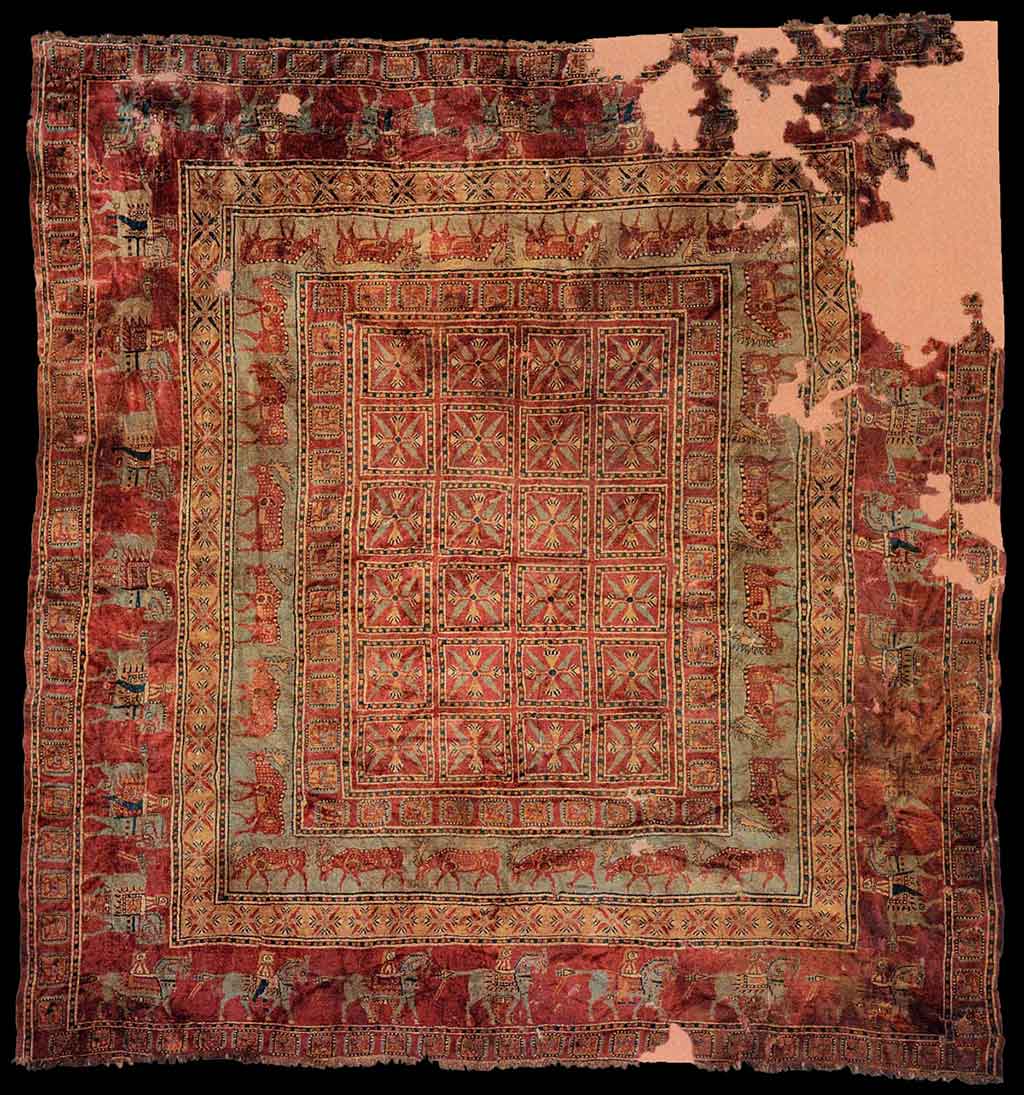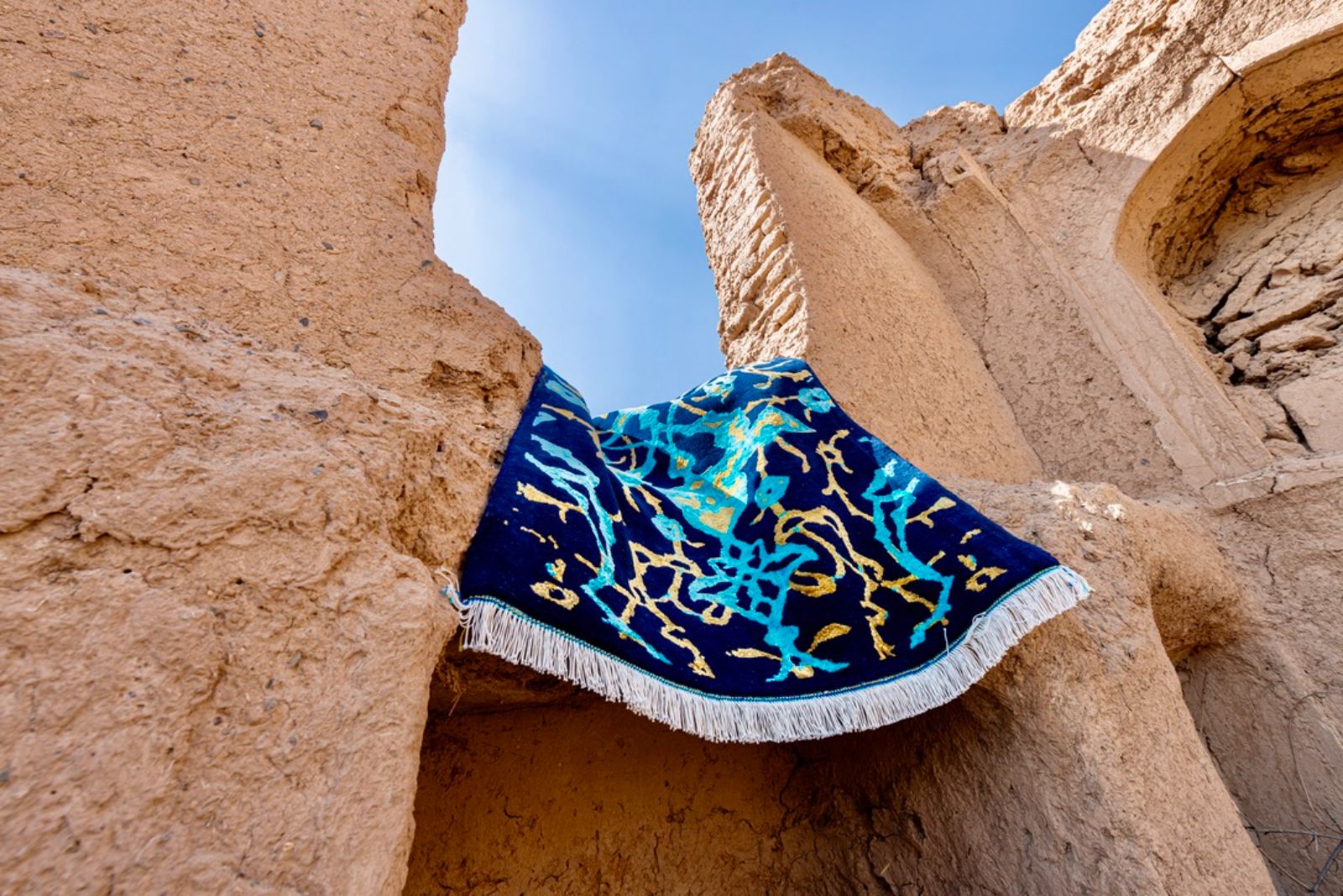ریشه های فرش: سفری از طریق زمان و فرهنگ
فرش ها، همراهان آرامش بخشی که کف خانه های ما را زینت می بخشند، تاریخچه ای غنی و جالب توجه دارند که هزاره ها و قاره ها را در بر می گیرد.
ریشه تاریخچه ی فرش را می توان به قبایل عشایری تمدن های باستان ردیابی کرد، جایی که آنها نه تنها به عنوان کفپوش کاربردی بلکه به عنوان نمادهای هویت فرهنگی و بیان هنری نیز نقش ایفا می کردند.
نخستین نشانه های بافت فرش
قدیمی ترین مدرک بافت فرش به پنجمین هزاره قبل از میلاد باز می گردد، با قطعاتی از پارچه های پیچیده بافته شده در Pazyryk، سیبری. این قطعات شگفت انگیز، معروف به فرش های پازیریک، نشانگر تکنیک های پیشرفته بافت و حساسیت های هنری بافندگان اولیه فرش است.

قبایل عشایری و سنت بافندگی فرش
قبایل عشایری نقشی محوری در توسعه بافت فرش داشتند. همانطور که آنها از سرزمین های وسیع عبور می کردند، این جوامع دانش و مهارت خود را با خود حمل می کردند، تکنیک های بافت خود را با مواد موجود در مناطق مربوطه خود تطبیق می دادند. فرش های آنها اغلب دارای الگوهای هندسی و المان های منعکس کننده میراث فرهنگی منحصر به فرد آنها بودند.
مرکز های بافندگی اولیه و تکنیک ها
با گذشت زمان، مراکز بافندگی متمایز در سراسر جهان ظهور کرد، هر کدام سبک ها و تکنیک های متمایز خود را توسعه دادند. به عنوان مثال، در مصر باستان، بافندگان از تکنیک های گره زدن پیچیده برای ایجاد فرش با رنگ های پر جنب و جوش و طرح های پیچیده استفاده می کردند.
جاده ابریشم و گسترش بافندگی فرش
جاده ابریشم، شبکه ای از مسیرهای تجاری که شرق و غرب را به هم متصل می کرد، نقشی حیاتی در انتشار دانش و تکنیک های بافندگی فرش داشت. همانطور که تاجران در امتداد این مسیرها سفر می کردند، آنها نه تنها کالاها بلکه مهارت ها و سنت های بافندگی فرش را نیز با خود حمل می کردند، منجر به تبادل فرهنگی ایده ها و طرح ها شد.
ظهور بافندگی فرش در ایران
فرش دستباف ایرانی یکی از هنرهای سنتی و ارزشمند ایران است که قدمت آن به هزاران سال پیش باز می گردد. این هنر در طول تاریخ، همواره مورد توجه و علاقه ایرانیان بوده است و امروزه نیز یکی از مهم ترین نمادهای فرهنگ و هنر ایران محسوب می شود.
قدمت بافندگی فرش در ایران
قدمت بافندگی فرش در ایران به هزاران سال پیش باز می گردد. قدیمی ترین فرش های دستباف ایرانی که تاکنون کشف شده اند، مربوط به دوره ماد (800 تا 550 قبل از میلاد) می باشند. این فرش ها در مناطقی مانند کاشان، کرمان و فارس بافته شده اند و دارای طرح ها و نقوش ساده ای هستند.
با گذشت زمان، بافندگی فرش در ایران رونق بیشتری پیدا کرد و به تدریج طرح ها و نقوش پیچیده تری در فرش ها به کار گرفته شد. در دوره ساسانیان (224 تا 651 میلادی)، فرش های دستباف ایرانی به اوج شکوفایی خود رسیدند و به سایر نقاط جهان نیز صادر شدند.
عوامل موثر در ظهور بافندگی فرش در ایران
عوامل مختلفی در ظهور بافندگی فرش در ایران نقش داشته اند. از جمله این عوامل می توان به موارد زیر اشاره کرد:
- وجود منابع طبیعی مناسب: ایران از دیرباز دارای منابع طبیعی مناسبی برای بافندگی فرش بوده است. این منابع شامل پشم، ابریشم و رنگ های طبیعی می باشند.
- وجود فرهنگ غنی: ایران دارای فرهنگ غنی و پرباری است که از گذشته های دور مورد توجه بوده است. این فرهنگ، زمینه را برای رشد و توسعه هنرهای سنتی مانند بافندگی فرش فراهم کرده است.
- وجود شرایط مناسب آب و هوایی: آب و هوای مناسب ایران، به ویژه در مناطق کوهستانی، شرایط مناسبی را برای پرورش دام و تولید پشم فراهم کرده است. این امر نیز به رونق بافندگی فرش در ایران کمک کرده است.
انواع فرش دستباف ایرانی
فرش های دستباف ایرانی در انواع مختلفی بافته می شوند. از جمله این انواع می توان به موارد زیر اشاره کرد:
- فرش های ساده: این فرش ها دارای طرح های ساده و تکرار شونده هستند. از جمله معروف ترین فرش های ساده می توان به فرش های گلیم، ورنی و سوماک اشاره کرد.
-
فرش سوماک ایرانی
- فرش های طرح دار: این فرش ها دارای طرح های پیچیده و متنوعی هستند. از جمله معروف ترین فرش های طرح دار می توان به فرش های کاشان، کرمان، تبریز و مشهد اشاره کرد.
اهمیت فرش دستباف ایرانی
فرش دستباف ایرانی علاوه بر زیبایی و ارزش هنری، دارای اهمیت اقتصادی و اجتماعی نیز می باشد. این هنر، یکی از مهم ترین منابع درآمد برای بسیاری از خانوارها در ایران است. همچنین، فرش دستباف ایرانی به عنوان یک کالای صادراتی مهم، نقش مهمی در اقتصاد کشور ایفا می کند.
در ادامه به برخی از مهم ترین دلایل اهمیت فرش دستباف ایرانی اشاره می کنیم
- زیبایی و ارزش هنری: فرش دستباف ایرانی یکی از زیباترین و ارزشمندترین هنرهای سنتی ایران است. این هنر، سالیان متمادی مورد توجه ایرانیان و سایر مردم جهان بوده است
- اهمیت اقتصادی: خرید فرش دستباف ایرانی یکی از مهم ترین منابع درآمد برای بسیاری از خانوارها در ایران است. همچنین، فرش دستباف ایرانی به عنوان یک کالای صادراتی مهم، نقش مهمی در اقتصاد کشور ایفا می کند.
- اهمیت فرهنگی: فرش دستباف ایرانی یکی از مهم ترین نمادهای فرهنگ و هنر ایران است. این هنر، نشان دهنده تاریخ و فرهنگ غنی ایران می باشد.
فرش دستباف ایرانی، هنری ماندگار
فرش دستباف ایرانی، هنری ماندگار و ارزشمند است که از گذشته های دور مورد توجه ایرانیان و سایر مردم جهان بوده است. این هنر، سالیان متمادی به عنوان یکی از مهم ترین صنایع دستی ایران شناخته می شود و نقش مهمی در اقتصاد و فرهنگ کشور ایفا می کند.
تکامل بافندگی فرش
در طول تاریخ، بافندگی فرش به طور مداوم تکامل یافته است، با تغییر سبک زندگی، فناوری ها و تأثیرات هنری، سازگار شده است. معرفی مواد جدید، مانند پنبه و ابریشم، دامنه امکانات را برای فرش بافندگان گسترش داد، در حالی که نوآوری های در تکنیک های بافت منجر به ایجاد طرح های پیچیده و پیچیده تر شد.
فرش ها به عنوان بیانیه های فرهنگی
فرش ها فراتر از هدف صرفاً کاربردی خود رفته اند تا به بیانیه های فرهنگی قدرتمند تبدیل شوند. طرح ها و مورهای آنها اغلب منعکس کننده باورها، سنت ها و حساسیت های هنری جوامع تولید کننده آنها هستند. فرش ها پیوندهای ملموسی با گذشته هستند و میراث فرهنگی و داستان گویی را از طریق الگوهای پیچیده و رنگ های زنده خود حفظ می کنند.
فرش ها، همراهان آرامش بخشی که کف خانه های ما را زینت می دهند، تاریخچه ای غنی و جالب توجه دارند که هزاره ها و قاره ها را در بر می گیرد. ریشه آنها را می توان به قبایل عشایری تمدن های باستان ردیابی کرد، جایی که آنها نه تنها به عنوان کفپوش کاربردی بلکه به عنوان نمادهای هویت فرهنگی و بیان هنری نیز خدمت می کردند.













